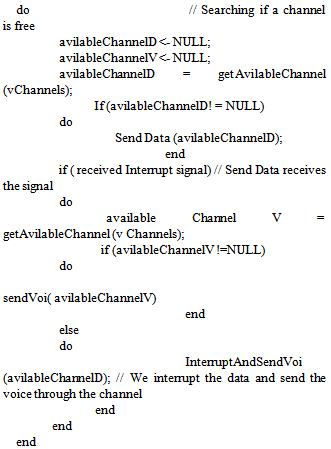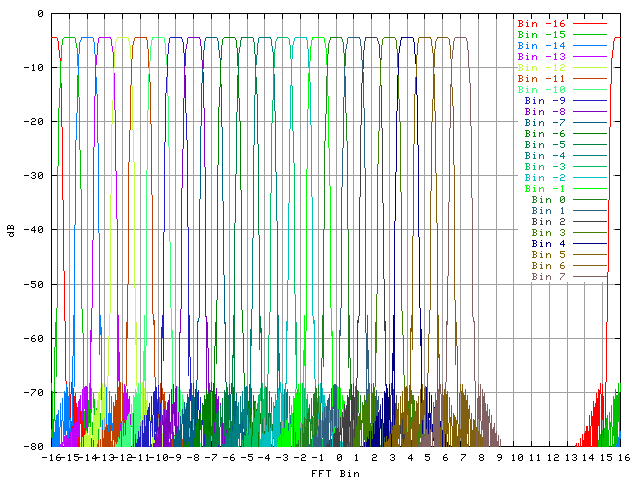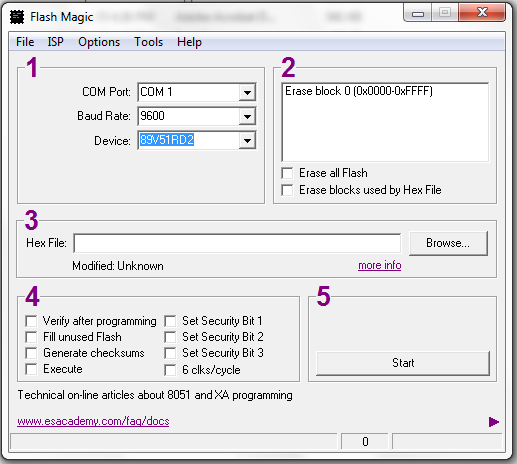-
Paper Information
- Previous Paper
- Paper Submission
-
Journal Information
- About This Journal
- Editorial Board
- Current Issue
- Archive
- Author Guidelines
- Contact Us
Algorithms Research
p-ISSN: 2324-9978 e-ISSN: 2324-996X
2013; 2(1): 24-28
doi:10.5923/j.algorithms.20130201.05
Effective Utilization of Radio Channels Using Polyphase Filter Banks
Ch. R. Phani Kumar1, P. Krishna Mohan2, Ch. Satyavathi2
1Department of ECE, GITAM University, Visakhapatnam, 530045, India
2Department of EIE, GITAM University, Visakhapatnam, 530045, India
Correspondence to: Ch. R. Phani Kumar, Department of ECE, GITAM University, Visakhapatnam, 530045, India.
| Email: |  |
Copyright © 2012 Scientific & Academic Publishing. All Rights Reserved.
Data processing through cellular networks has been increased in the present decades. Huge amount of data can cause interruption to the cellular users. Hence a code has been generated that acts as a filter bank. Placing the code into the controlling element of the filter banks required selection of the channels for allocating the voice and data channels are made. By allocating the free channels to the calls, the user can able to provide service to all the calls and also to the data when any channel is free. Even the feedback for the lost data is also provided in such a way that all the channels in one or the other case are kept busy either by voice or data transmissions. Hence the code can provide effective utilization of the channels during data transmission.
Keywords: Filterbanks, Algorithm, Radio Channels
Cite this paper: Ch. R. Phani Kumar, P. Krishna Mohan, Ch. Satyavathi, Effective Utilization of Radio Channels Using Polyphase Filter Banks, Algorithms Research, Vol. 2 No. 1, 2013, pp. 24-28. doi: 10.5923/j.algorithms.20130201.05.
1. Introduction
- While the cellular revolution has made voice connectivity ubiquitous in the developing world, data services are largely absent or are prohibitively expensive[1]. In recent years, many developing countries have undergone a cellular revolution with a significant proliferation of digital cellular networks in rural areas[2, 3]. In addition to voice calls, these networks provide SMS text messaging services that can serve as a rudimentary data layer. While it is technically easy to provide enhanced data services on top of a digital cellular network, economic factors prevent the cellular carriers from providing it. Under these extreme conditions, we ask the question: Given the ubiquity of cellular coverage, can we provide any form of data connectivity services over the cellular network? While SMS is available as a possible data channel, it is extremely low-bandwidth, where every SMS message is limited to 140 bytes and furthermore, the cost per bit is quite high[4, 5]. In most areas, a single SMS costs between $0.05 to $0.25 that is comparable to per-minute voice call rates[4]. Hence, if there exists an efficient data connectivity service over the cellular voice channel, one can enable a new class of mobile data services and also significantly reduce the cost per bit for data connectivity. A traffic channel is used to carry speech and data traffic.[6] In some cases the transmission over data channel is not possible or not convenient, which makes the voice channel an interesting alternative. Firstly speech channels have an advantage of availability. The network coverage of speech channels is still wider than communication channels. The transmission over voice channel allows higher service availability and better robustness, offers the possibility of switching from secure data transmission to voice communication. Lastly for security matters, transmitting data dissimulated in a voice-like signal is more discrete. Some well-known and largely used applications are based on the transmission of data signals through speech coders and speech dedicated communications channels, at very low bit rates[7].
2. Methodology
- Communicating data from one location to another requires some form of pathway or medium. These pathways are called as communication channel. Common-channel signaling (CCS) is the transmission of signaling information (control information) on a separate channel from the data, and, more specifically, where that signaling channel controls multiple data channels. A channel has a certain capacity for transmitting information, often measured by its bandwidth in Hz or its data rate in bits per second. A data channel also known as a "handshake" channel, is the control channel. The control channel can change every day because it switches to a different repeater every day. A voice channel is that with a bandwidth sufficiently great to accommodate speech. One of the most crucial factors in responding to and recovering from any emergency or disaster is the ability to see and understand what is happening throughout the area involved. This understanding or seeing is what we call situational awareness. There are two ways to achieve this. Either through voice descriptions or through the exchange of information (data), and both are important to the overall understanding of what is going on and what needs to be done. The combination of the two can allow responders to better analyze the circumstances, review available options and make better and faster decisions. Here comes our project where we deal with effective utilization of the channels where we consider a case of 42 channels in which 40 channels are used for both the data and voice allocations. The other two channels are totally dedicated to the voice channels only. Our work comes into existence in writing a code for the algorithm for the cases as we are given. Out of the 40 channels there might be the case of where all the channels might be busy on calls. The same case with the two data channels. We approach with the idea of how to allocate the call and the data information to the channels as per the algorithm which is given below:Step 1: Here we consider 42 channels.(Out of which 40 are for voice and data transmissions, other two are only for data transmission)Step 2: Initially, we have all the 40 voice channels are free to use. We allocate all the channels for the calls by searching the free channel.Step 3: When all the available calls are allocated and when we want to send the data we need to search for the channels free or complete its part of work and place the data into that channel.Step 4: When a new call comes now the same step 2 is to be followed.Step 5: When all the channels are busy and when a voice call comes as input at that time the channel in which the data is transmitting is interrupted and the voice calls are allowed to transmit through that channel.Step 6: Acknowledgement for the lost data or the interrupted data is given back to the input end.Channel Utilization: (Multi-Threading might be required)Input: Array List of 40 Voice Channels <- v ChannelsInterrupt Signal <- sigInt (Boolean) Comes from the system monitoring the voice channelsChannel Utilization (vChannels)

3. Results
- In signal processing, a filter bank is an array of band-pass filters that separates the input signal into multiple components, each one carrying a single frequency Sub-band of the original signal. An important application of filter banks is signal compression, when some frequencies are more important than others. After decomposition, the important frequencies can be coded with a fine resolution. Coming to the filter banks they have multiple inputs and multiple outputs. Filter Banks are part of a group of a signal processing techniques that decompose signals into frequency sub-bands. This decomposition is useful because frequency domain processing has advantages over time domain processing .Due to their computational requirements, filter banks are typically implemented in FPGA’s or ASIC’s.Filter banks find application in communications, speech processing, image compression, antenna systems, analog voice privacy systems, and in the digital audio industry. During the last several years there has been substantial progress in multi-rate system research.A bank of receivers can be created by performing a sequence of FFTs on overlapping segments of the input data stream. A weighting function is applied to each segment to control the shape of the frequency responses of the filters. The wider the shape, the more often the FFTs have to be done to satisfy the Nyquist sampling criteria (which is what distinguishes a filter bank from a spectrum. For a fixed segment length, the amount of overlap determines how often the FFTs are done. Also, the wider the shape of the filters, the fewer filters that are needed to span the input bandwidth. Eliminating unnecessary filters is efficiently done by treating each weighted segment as a sequence of smaller blocks, and the FFT is performed on only the sum of the blocks. This has been referred to as multi-block windowing and weighted pre-sum FFT.A bank of receivers can be created by performing a sequence of FFTs on overlapping segments of the input data stream. A weighting function is applied to each segment to control the shape of the frequency responses of the filters. The wider the shape, the more often the FFTs have to be done to satisfy the Nyquist sampling criteria (which is what distinguishes a filter bank from a spectrum. For a fixed segment length, the amount of overlap determines how often the FFTs are done. Also, the wider the shape of the filters, the fewer filters that are needed to span the input bandwidth. Eliminating unnecessary filters is efficiently done by treating each weighted segment as a sequence of smaller blocks, and the FFT is performed on only the sum of the blocks. This has been referred to as multi-block windowing and weighted pre-sum FFT.Here in this paper we are providing a methodology through which by placing the code into the controlling element of the filter banks the required selection of the channels for allocating the voice and data channels are made. By default the selection of the channels is made with the help of the code which is written with the help of the algorithm.The designed code for the channel allocation algorithm needs to be dumped into the processing unit. The processing unit is a microcontroller with minimal processing capabilities. A Philips P89V51RD2BN microcontroller based on the 8051 microcontroller would suit this purpose.The code written in embedded C can be dumped into the microcontroller using a software dumper like Flash Magic. Flash Magic is a PC tool for programming flash based microcontrollers from NXP using a serial or Ethernet protocol while in the target hardware. This is a flashing program used to burn the code that has been compiled earlier in embedded C. The microcontroller is the processing unit of the filter bank. It allocates the channels (i.e., either data or voice) based on the provided algorithm. The selection of channels is done by selecting the required filter in the filter bank.
 | Figure 1. Polyphase filter bank with four times overlap; frequency response of several bins |
 | Figure 2. Filter Bank |
 | Figure 3. Flash Magic Terminal |
4. Discussion
- Wireless communications is one of the active areas of technology developments of our time. This development is being driven primarily by transformation of what has been largely a medium for supporting voice telephony in to a medium for supporting other services, such as the transmission of video, images, text and data[8].The development of wireless and web technologies has allowed the mobile users to request various kinds of services by mobile devices at anytime and anywhere. Helping the users obtain needed information effectively is an important issue in the mobile web systems[9].The RADIO spectrum available for wireless communications is extremely scarce, while demand for mobile and personal communications is growing at a rapid pace. Spectral efficiency is therefore of primary concern in the design of future wireless communications systems. Furthermore, these systems will have to support not only voice services but also data services including facsimile, file transfer, e-mail, and Internet access[10].Because the radio spectrum is limited, managing the limited amount of resources is an important issue, especially for high-speed data applications[11].There are various types of applications demands the data has to be transmitted from one location to another location. If the data channels of Mobile are not available then now they can be transmitted over voice securely. Data channels of Global System Mobile are GPRS, EDGE and HSDPA. But these channels required specific infrastructure present on the Telecom Tower[12].This paper gives an overview of the Distant gathering system where data is been sent from remote location to central server using GSM voice channel as the unavailability of other data channel of the GSM network. Another advantage of using Voice channel is cost. As the cost is also an important criterion of the Op-Ex model business, where recurring cost becomes vital[6].The voice calls have priority over the data packets, in that the data packets are transmitted only when there are no voice calls present in the system or the voice conversation is in a long silent period[13].
5. Conclusions
- A communication apparatus and method for channel switching for communication provides effective utilization of an infrastructure communication channel while preventing deterioration in the quality of the infrastructure communication affected by a transmission signal used in the communication. The channel efficiency, also known as bandwidth utilization efficiency. In this paper by allocating the free channels to the calls we are able to provide service to all the calls and also to the data when any channel is free ,even the feedback for the lost data is also provided in such a way that all the channels in one or the other case they are kept busy either by voice or data transmissions so by which the effective utilization of the channels is made.
ACKNOWLEDGEMENTS
- Authors would like to thank management and staff of GITAM University, India for their kind support in bringing out the above literature and providing lab facilities.
 Abstract
Abstract Reference
Reference Full-Text PDF
Full-Text PDF Full-text HTML
Full-text HTML